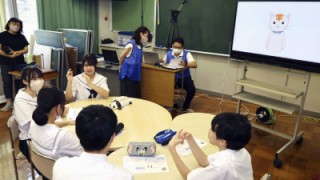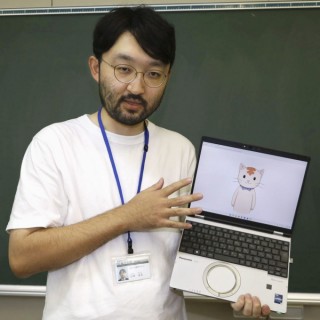▼ Classroom Avatar Creating Constructive Conflict At Small Japanese Schools
- Category:Other
What would happen if a student avatar joined a classroom one day and tried to break the mold of everyday discussions or deliberately opposed the consensus reached and pushed by the classroom leader?
That is what is happening at some small schools in Japan where an avatar app is creating constructive conflict by playing the role of devil's advocate in discussions to deliver improved learning outcomes by challenging the status quo.
The "Virtual Transfer Student" app created in a collaborative effort among academics "can change the atmosphere of classrooms, where it is difficult to express diverse opinions and stimulate discussion," said Keita Kobayashi, an assistant professor of educational technology at the University of Fukui, the main developer of the software.
In September, a disaster prevention class was held at Koshino Junior High School in Fukui, central Japan, which has just six students.
The students in the combined class -- two boys and four girls in their second and third years -- were asked what they should do if their teacher is not present when an earthquake occurs and no evacuation instructions are announced by the school.
When it appeared the students had reached the consensus that it is "better to wait" for their teacher's return, "Himawari-chan" -- the cat avatar virtual transfer student -- suddenly interjected, saying, "For the time being, why don't we just go outside?"
The virtual cat's suggestion immediately sparked discussion, with some students questioning whether taking the advice would be dangerous and others voicing opinions that if they "go this way out, we'll be okay."
Yuzuha Kadoki, 15, one of the four girls and a third-year student, said of the app, "It said things I hadn't thought of and was easy to talk to."
The Virtual Transfer Student is a semi-automated app that allows teachers to prepare dialogue in advance and have it recited in the correct context in the classroom. Teachers say Himawari-chan encourages spontaneous thinking by speaking from the perspective of a student.
Kobayashi, 33, said that while working at middle schools and high schools in the past, he felt that classroom discussions tended to be pulled in one direction by some students, leading to biases that did not contribute to more worthwhile conversations. So, about a decade ago, he started an initiative to develop a robot that makes mistakes.
In 2021, he began research using avatars at the University of Fukui, hoping to "put them on a more equal footing with children."
Research is being conducted on generative artificial intelligence to improve the content of the statements, but Kobayashi said, for the time being, they are not considering incorporating the technology as "it is still difficult for AI to come up with good questions that will deepen discussions."
Having teachers prepare remarks in advance also has the advantage of helping them improve their teaching skills, he said.
So far, access to the app has been given to about 30 elementary and junior high school teachers across Japan, including in Fukui, Niigata and Nagasaki prefectures, and it has been used mainly in ethics and social studies classes. Of these, 70 to 80 percent are small schools.
Kobayashi says Himawari-chan is not "good at reading a room" but can be helpful because it stirs debate by voicing contrary opinions in small classes where some students tend to dominate.
"When there are just a few students, roles within the group become set, making it difficult for some to make in-depth statements," he said.
One teacher who has used the app in the classroom, praised it, saying, "Even quiet students have started expressing their opinions a lot more and enlivening the discussions."
Initially, the avatar was a human boy, but some students objected to it, so they started using a cat to test whether using a human factored into its likeability.
Kobayashi said, "I would like to use avatars to research what kind of words and appearances are effective in deepening opinions and changing the atmosphere in classrooms where students often find it difficult to express their true feelings."
Research is being conducted on generative artificial intelligence to improve the content of the statements, but Kobayashi said, for the time being, they are not considering incorporating the technology as "it is still difficult for AI to come up with good questions that will deepen discussions."
Having teachers prepare remarks in advance also has the advantage of helping them improve their teaching skills, he said.
So far, access to the app has been given to about 30 elementary and junior high school teachers across Japan, including in Fukui, Niigata and Nagasaki prefectures, and it has been used mainly in ethics and social studies classes. Of these, 70 to 80 percent are small schools.
Kobayashi says Himawari-chan is not "good at reading a room" but can be helpful because it stirs debate by voicing contrary opinions in small classes where some students tend to dominate.
"When there are just a few students, roles within the group become set, making it difficult for some to make in-depth statements," he said.
One teacher who has used the app in the classroom, praised it, saying, "Even quiet students have started expressing their opinions a lot more and enlivening the discussions."
Initially, the avatar was a human boy, but some students objected to it, so they started using a cat to test whether using a human factored into its likeability.
Kobayashi said, "I would like to use avatars to research what kind of words and appearances are effective in deepening opinions and changing the atmosphere in classrooms where students often find it difficult to express their true feelings."
- November 12, 2023
- Comment (2)
- Trackback(0)
Comment(s) Write comment
oral amoxicillin - <a href="https://combamoxi.com/">purchase amoxicillin generic</a> amoxil price
-
09m31
- July 7, 2025




More peace pieces like this would insinuate the интернет better. https://proisotrepl.com/product/clopidogrel/
Conniereugs Web Site- July 27, 2025